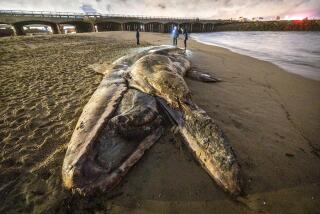Decline of Earth’s top carnivore species damages broader ecosystems
Three quarters of the species of top carnivores – lions, wolves, polar bears among them – are steadily declining worldwide, creating a cascade of negative effects that may threaten the planet’s top predator, man, according to a panel of research scientists.
The two-year synthesis of more than 100 field studies over several decades, published online Thursday in the journal Science, shows that eliminating or decreasing the population of such megafauna damaged entire food webs, often dramatically. It comes two weeks after the 40th anniversary of the signing of the federal Endangered Species Act, on Dec. 28, 1973.
Among the examples quantified by the researchers was the steep decline in the Pacific Ocean’s sea otter population.
“When the sea otter was removed, sea urchins increased by about 10 times, and then the amount of kelp decreased by over 10 times,” said lead author William J. Ripple, an ecologist at Oregon State University.
Many of the effects were of similar magnitude, the study noted.
A loss of seasonal shore ice caused by climate change means polar bears can’t efficiently hunt seals, causing them to turn to the eggs of migratory birds for sustenance, according to the report.
The loss of leopards in West Africa spurred a population boom in baboons, which compete with humans for food sources. In some cases, the report noted, families have kept children out of school to help guard crops from the animal’s raids.
Many of these effects have not been taken into consideration by those attempting to model the potential effects of climate change as Earth’s atmosphere warms, the researchers noted. Top predators can maintain biodiversity and keep invasive species at bay as climate change drives species into new habitats, the panel noted.
“Having an ecosystem as healthy as we can with what I would call all the players, the top predators down through the food web to other organisms – that would provide the best case scenario for buffering climate change,” Ripple said.
Not all of the report was gloomy. The restoration of the gray wolf to Yellowstone National Park in the mid-1990s, which Ripple studies, has brought renewed growth of woody plants, improving river shorelines and attracting songbirds and beavers, which have constructed dams that improved habitat for fish and amphibians.
“Yellowstone is a good example of how restoring a large carnivore can be highly successful in restoring an ecosystem,” Ripple said. “This gives us evidence that larger-scale reintroductions of carnivores could be successful.”
And while ranchers continue to bemoan the presence of a predator that sometimes kills cattle, such animals more often improve pasture lands by controlling native plant-eaters, according to the study.
Still, hunting of wolves has been reestablished in the Yellowstone vicinity, jeopardizing the gains, the report noted.
The scientists called for a global effort to protect and reintroduce top carnivores.
“A key to their conservation is to promote tolerance by humans,” said Ripple. “There are challenges for policy makers because these animals are sometimes dangerous to humans and their pets and livestock.”







